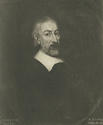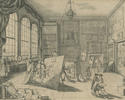 The first part of this period is marked by a similar lack of material to that prior to the Reformation. Glasgow is noted as the home of fewer than fifteen of over 200 painters recorded in Scotland between the 1560s and 1700. The difficulties facing the profession may be exemplified by one Harry Ross (fl.1597), who appeared before the Glasgow Presbytery on 2 August 1597 and denied "that he payntit the pictures of the Father, the Sone and the Haly Gaist, in any houssis within this realme."
The first part of this period is marked by a similar lack of material to that prior to the Reformation. Glasgow is noted as the home of fewer than fifteen of over 200 painters recorded in Scotland between the 1560s and 1700. The difficulties facing the profession may be exemplified by one Harry Ross (fl.1597), who appeared before the Glasgow Presbytery on 2 August 1597 and denied "that he payntit the pictures of the Father, the Sone and the Haly Gaist, in any houssis within this realme."
 More typical were the transactions of the Littlejohn family, Gavin (1) (fl.1656-9), Gavin (2) (fl.1689-91), Robert (fl.1624-d.ante1659), and William (fl.1660). Gavin (1) was paid £14 by the University in October 1656 for "oyleing and cullouring the new heigh chamber in the Principallis house…" By the end of the 17th century both town council and the University were giving commissions for portrait paintings to Scottish painters including John Scougall (c.1645-1737).
More typical were the transactions of the Littlejohn family, Gavin (1) (fl.1656-9), Gavin (2) (fl.1689-91), Robert (fl.1624-d.ante1659), and William (fl.1660). Gavin (1) was paid £14 by the University in October 1656 for "oyleing and cullouring the new heigh chamber in the Principallis house…" By the end of the 17th century both town council and the University were giving commissions for portrait paintings to Scottish painters including John Scougall (c.1645-1737).
 The town was not, however, a productive source of commissions for any artist, native or otherwise. The greatest name to emerge from Glasgow at this time was the neo-classical painter, Gavin Hamilton (1723-1798), who studied at the University between 1738 and 1742 before settling in Rome. At what point his interest in painting was sparked is unknown, but the teaching of Francis Hutcheson (1694-1746) was undoubtedly as influential on Hamilton, as it was on the typographers-turned-academicians, the brothers Robert (1707-1776) and Andrew Foulis (1715-1775). Their Academy, which operated in the University from the 1750s to the 1770s, using an extensive collection of pictures gathered specially for teaching, produced few artists of any quality.
The town was not, however, a productive source of commissions for any artist, native or otherwise. The greatest name to emerge from Glasgow at this time was the neo-classical painter, Gavin Hamilton (1723-1798), who studied at the University between 1738 and 1742 before settling in Rome. At what point his interest in painting was sparked is unknown, but the teaching of Francis Hutcheson (1694-1746) was undoubtedly as influential on Hamilton, as it was on the typographers-turned-academicians, the brothers Robert (1707-1776) and Andrew Foulis (1715-1775). Their Academy, which operated in the University from the 1750s to the 1770s, using an extensive collection of pictures gathered specially for teaching, produced few artists of any quality.